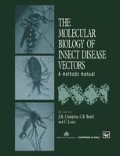Abstract
Due to the recent interest in the development of novel genetic methods to control insect vectors of disease, a great deal of research has focused on the genetic manipulation of the insect vector (James, 1992). In the design of a control programme involving genetic modification of the insect vector, factors to be considered include the isolation of potentially useful target genes, appropriate tissue-specific control elements to direct their expression, and a means of introducing exogenous DNA into the insect genome.
Access this chapter
Tax calculation will be finalised at checkout
Purchases are for personal use only
Preview
Unable to display preview. Download preview PDF.
References
Clements, A.N. (1992) The Biology of Mosquitoes Vol I, Development, Nutrition and Reproduction. Chapman and Hall, London.
James, A.A. (1992) Mosquito molecular genetics: the hands that feed bite back. Science257, 37–38.
Karess, R.E. (1985) P element mediated germline transformation of Drosophila. In DNA Cloning: A Practical Approach (D.M. Glover, ed.), Vol. II, pp. 121–141. IRL Press, Oxford.
McGrane, V., Carlson, J.O., Miller, B.R. and Beaty, B.J. (1988) Micro-injection of DNA into Aedes triseriatus ova and detection of integration. Am. J. Trop. Med. Hyg.39, 502–510.
Miller, L.H., Sakai, R.K., Romans, P., Gwadz, R.W., Kantoff, P. and Coon, H.G. (1987) Stable integration and expression of a bacterial gene in the mosquito Anopheles gambiae. Science237, 779–781.
Morris A.C., Eggleston, P. and Crampton, J.M. (1989) Genetic transformation of the mosquito Aedes aegypti by micro-injection of DNA. Med. Vet. Ent.3, 1–7.
Morris, A.C., Schaub, T.L. and James, A.A. (1991) FLP-mediated recombination in the vector mosquito, Aedes aegypti. Nucl. Acids Res.19, 5895–5900.
Morris, A.C., Pott, G.B., Chen, J. and James, A.A. (1995) Transient expression of a promoter-reporter construct in differentiated adult salivary glands and embryos of the mosquito Aedes aegypti. Am. J. Trop. Med. Hyg.52, 456–460
Sambrook, J., Fritsch, E.F. and Maniatis, T. (1989) Molecular Cloning: A Laboratory Manual, 2nd edn. Cold Spring Harbor Laboratory Press, Cold Spring Harbor, New York.
Editor information
Editors and Affiliations
Rights and permissions
Copyright information
© 1997 Chapman & Hall
About this chapter
Cite this chapter
Morris, A.C. (1997). Microinjection of mosquito embryos . In: Crampton, J.M., Beard, C.B., Louis, C. (eds) The Molecular Biology of Insect Disease Vectors. Springer, Dordrecht. https://doi.org/10.1007/978-94-009-1535-0_35
Download citation
DOI: https://doi.org/10.1007/978-94-009-1535-0_35
Publisher Name: Springer, Dordrecht
Print ISBN: 978-94-010-7185-7
Online ISBN: 978-94-009-1535-0
eBook Packages: Springer Book Archive

